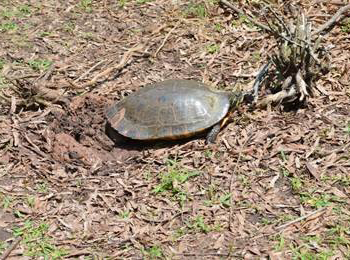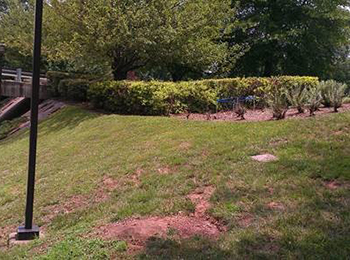Myrtle the Turtle Lays Eggs
Myrtle the Turtle Lays Eggs

By the Environmental Awareness Advisory Committee Wildlife and Industry Together (WAIT) Program
July 10, 2014
The day was Friday, June 13th shortly after noon when up on the bank a turtle about the size of a dinner plate was seen, well away from the water. Upon closer inspection it turned out to be a River Cooter (Pseudemys concinna concinna), similar to the one that had laid eggs near the First Environments Center in 2012. Could this be another case of turtle egg drop? It surely looked like it might be, for the timing was right. As she finished digging the hole near the south parking lot walkway, she paused for a few minutes. Then, with a horizontal right to left motion, she began depositing white eggs into the hole. The approximately 1 ¼” elliptical eggs were placed one at a time with each pass of her body across the hole. After the last eggs was deposited, she continued the left to right motion, but this time pushing the excavated soil into the hole until it was hard to tell where the eggs had been placed. A rain would definitely obscure what had happened this day.
Thanks to a camera from CMB she was photographed as she covered her eggs. To reach this location, she must have crossed at least four lanes of traffic, probably one parking lot, one access road, and two sidewalks, a distance of 832 feet. To insure a safe return to Discovery Lake, she was not allowed to take a similar path back to the lake. As shown in the picture below, the location of the nest has been cordoned off so that no digging or disturbance will occur around the nest. This will allow Nature to run her course without endangering the egg through man’s activities.

The River Cooter usually nests in open areas within 100 feet of water. A clutch can range from 10-25 but is usually around 15 eggs. With laying on June 13th, we should know in about 90-100 days, depending on summer temperatures, how many of the baby turtles will hatch. Emerging generally takes place in August or September but, as observed with the First Environments Center, emerging might not occur until the Spring of 2015. It has been noted that a late summer lay may hatch but the babies over winter in the nest before emerging.
This is one of the basking turtles that you might see on rocks and logs in and around the lake. It will share its perch with other species of basking turtle, even making turtle stacks. These turtles are very skittish and quickly enter the water at the slightest hint of danger.
One interesting structure in these turtles is the presence of an organ near the tail called the cloaca bursae that allows the turtle to breathe under water, thus allowing it to remain submerged longer than most other turtles.
Myrtle was very gentle and calm with us and pretty exhausted.
More information about the River Cooter can be found at:



